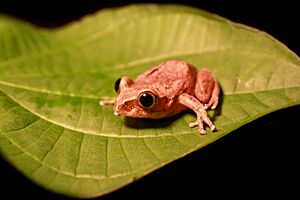Aubry's tree frog facts for kids
Quick facts for kids Aubry's tree frog |
|
|---|---|
 |
|
| Conservation status | |
| Scientific classification | |
| Synonyms | |
|
Hyla punctata Hallowell, 1855 "1854" |
Leptopelis aubryi is a type of frog often called the Aubry's tree frog or Gaboon forest treefrog. It belongs to the Arthroleptidae family. You can find this frog in many parts of Central and West Africa. These include countries like Nigeria, Cameroon, Gabon, and the Democratic Republic of the Congo. It also lives in Angola and other nearby nations.
Contents
What's in a Name?
The name aubryi comes from a person named Charles Eugène Aubry-Lecomte. He was a French official who also loved studying nature. The frog was named after him.
How Scientists Classify This Frog
Leptopelis aubryi looks a lot like another frog, Leptopelis spiritusnoctis, which lives in West Africa. For a while, scientists thought they might be the same species. However, by listening to their calls and studying their DNA, scientists found they are different.
In fact, the calls of L. aubryi vary quite a bit. This might mean that what we currently call L. aubryi could actually be several different, but very similar, frog species. These are sometimes called "cryptic species" because they are hard to tell apart.
What Does It Look Like?
Male Aubry's tree frogs are about 33 to 39 millimeters long. Females are a bit bigger, measuring 44 to 54 millimeters from snout to vent. Their backs are brown. They have a triangle shape on the back of their heads and round spots on their sides.
You might also see small, dark dots on their sides, especially near their legs. Sometimes, they have tiny white spots on their backs and limbs too.
Where Does It Live and How Is It Doing?
The Aubry's tree frog is an arboreal species, meaning it lives in trees. It can be found in different places, like secondary forests (forests that have grown back after being cut down) and swamp forests. It can even live in areas where forests have been changed by farming.
These frogs lay their eggs in a nest they bury in the mud. This nest is usually close to swamps or pools. When the eggs hatch, the tadpoles then develop in the water.
Leptopelis aubryi is a very adaptable frog. It is also quite common in the areas where it lives. You can find it in several protected places, such as the Korup National Park in Cameroon. It also lives in Monte Alén National Park in Equatorial Guinea. Scientists have not found any major threats to this frog species.


